ICEX-1 1986

These Arctic Operations Photographs
and narratives were provided by
QMCS(SS) Standlee and
ET1(SS) Parker
Both were on this Arctic Operation in 1986.
(Photographs captured from video by Dennis Parker.
Video supplied by Master Chief Standlee)
USS Ray was awarded the Arctic
Service Medal for
ICEX-1 1986

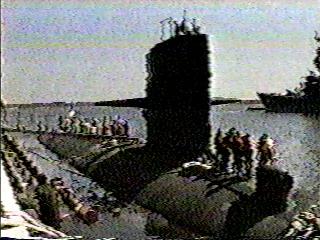
This is the RAY on the day that we put out of port for ICEX-86. This is either very late March, or early April. I cannot recall exactly when we left.
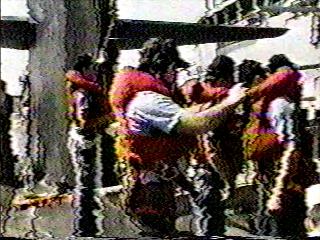
This is the topside crew as we prepare to leave port.I am the Weapons Shipping Hatch phone talker in the center foreground.
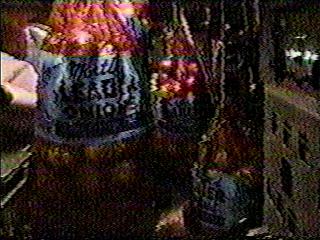
Sacks of onions hanging from the overhead. The boat was tightly packed for the long underway, and looked very much like the old images of W.W.II subs when they put out to sea with their large stores loads.
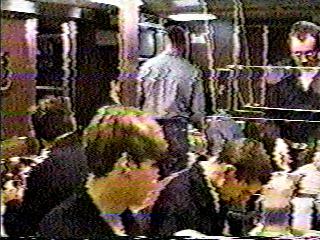
Cafe' Ray. This should be a familiar sight to the old sailors! In the left foreground is ET1(SS) Troy Eubank of RC Div. Beside him saying a blessing is MM2(SS) Mike Hylton. Mike was very religious, as is evidenced in this photo. He was one of the ship's divers. The doc's office door can be seen in the left background, and to the left is the Chiefs' table.
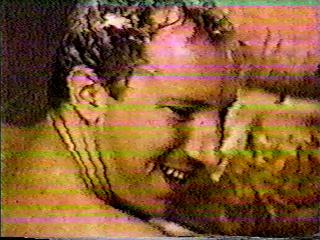
This is a picture from a very rare occurrence. A ROYAL Bluenose initiation. Since we did the
initiation underneath the North Pole, it was termed a ROYAL initiation (and we became
Royal Bluenoses), and was entered into our service records as this. I have put what is the
most memorable part in these two photos--removing the cherry from the Royal Baby's Royal
Belly. In this first shot Rick Gracey (ST2(SS), I think, but I am not sure) is
contemplating the unpleasant but necessary task.
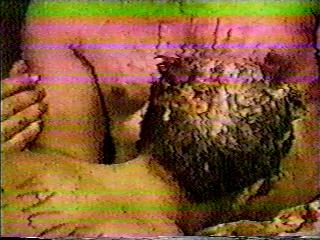
And in this shot, he goes for the cherry as buries his head in the belly. Note the condition of his hair, which has been rubbed with a greasy concoction of gunk prior to his coming to the Baby.
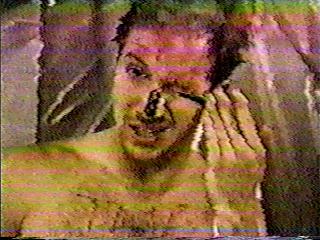
Rick Gracey is now a Bluenose. In honor of that achievement his nose has been painted blue! This was the end of the ceremony for each initiate. Prussion blue was the coloring of choice and did not come off easily if one let it set for long.
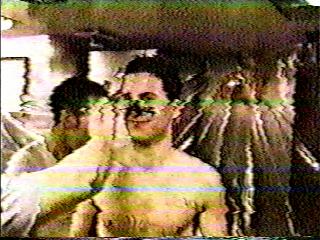
Another new Bluenose having his honorary coloring applied.
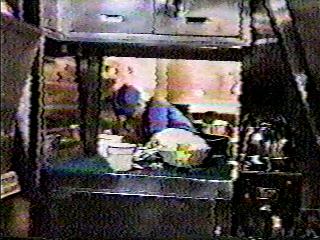
This scene should also be recognized by every RAY crewmember. This is the galley serving window. Just inside is one of the cooks dressed in the traditional garb. Just to the left inside the window is the pie rack, while to the right of the window is the Bunn coffee pot.
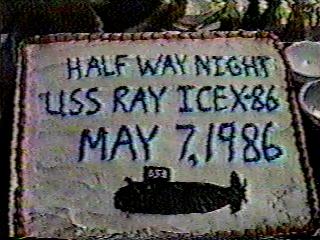
The cake prepared for the Halfway night celebration. This date is immediately following our surfacing at the North Pole (5/6/86). Halfway Night was a very memorable event. The aforementioned Rick Gracey appeared in sunglasses and fishnet nylons; TM2(SS) Don Meadows did a professional stand-up comic routine, special "awards" were given for a number of notable achievements, and the junior officers served the meal proceeding the ceremonies.
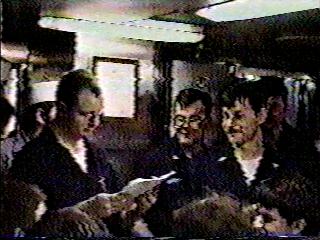
Halfway Night Awards presentations. On the left is TM2(SS) Don Meadows, and assisting him to the right is EMCS(SS) Dave Miller. Dave was the SEA (Senior Enlisted Advisor-the senior nuclear enlisted petty officer). Behind and between the two stands YNCS(SS) Edwards, the boats senior yeoman. Don Meadows was a real character aboard the boat. He had a very thorough knowledge of submarine history, was a very quick wit and natural comic, and was one of the favorite sailors on the boat, too.
The following narrative was written by Master Chief Standlee. In
this section we learn more about under ice operations.
The morning the Ray was scheduled to get underway for the Polar trip I found QM2 Standley standing aft in the control room near the ESGN consoles with a baby. He explained that his wife had disappeared some time during the night and left him with the baby. I immediately took him and the baby to see the Navigator. I explained the situation to the Navigator. We then met with Captain Johnson in the wardroom. The Captain thought for a couple of seconds and then gave QM2 Standley a couple of options: leave the baby with the base Chaplain, call his relatives, and have them notify Standley's wife as to the location of the baby or Standley could stay in Charleston but his stay would be in the Naval Station brig. As you will recall Standley did make the trip.
The Ray was underway basically on schedule. We surfaced transmitted the Cooper River into the Atlantic and then out to the dive point. The submerged transit took us north and east off the Outer Banks of Newfoundland Canada and back to the north into Baffin Bay. Just before we turned to the west into the northwest pass Master Chief Waddell had the honor of the first through the ice surface. Everyone on board the ship wanted to be in or near the control room during the evolution thus the chief of the watch had to keep running off hoards of visitors wanting to be in the control room. According to the couple of people who had the chance to peek from the periscope there were virtually whiteout conditions topside. Also no one left the ship to visit the ice during this surface.
The trip through the north west pass was without incident. The new navigation system was operating very well. ESGN was installed during the 84/85 overhaul and had proven reliable during all operations preceding the ICEX. However, at about this same time the R-12 plant began spewing freon into the atmosphere and 90 day limits were met and exceeded. The system was shutdown, system joints were taped, and an auxiliaryman was posted at the atmosphere monitoring gear on a continuous basis. The leading auxiliaryman took some verbal abuse from the Captain and friendly ribbing from the rest of the crew except the cooks.
The first ice station was located about 100 miles north of Point Barrow Alaska. We were to rendezvous at the ice station with the USS Hawkbill out of Hawaii for some sound testing and to shoot torpedoes at each other. But first because of the freon problem we left the ice station in search of a polynia (a thin area of ice) where we could surface and ventilate. After searching for a couple of hours an area of ice about 3 feet thick was located and the ship finally surfaced on the second try. The OOD went to the bridge, the top of the sail was cleared, the snorkel mast was raised and finally we were able to ventilate. The Auxiliary Division strung plastic hose from the R12 plant throughout the bridge access hatch and finally purged the system of freon. In addition all R12 bottles were off loaded through the bridge hatch and discarded over board on the ice.
We returned to the ice station and verified that their tracking system (a series of hydrophones dangling from the ice) would indeed track the ship. It did and operations began. Several torpedoes were fired from the Hawkbill at us (strata protection provided)to see how torpedoes would react in an under ice environment. This was also a test of our sonar tracking systems. The Ray also fired several torpedoes at the Hawkbill. Data were required from both submarines so logs were kept, plotting sheets were kept, ship's track was kept, and as the operation proceeded daily records were smoothed in report format and kept by the radiomen. Unfortunately one days worth of information was inadvertently shredded by a radioman. Hours and hours of work was spent by radiomen trying to reconstruct the days records. Radiomen were finally on the Captain's shit list. I'm sure the results of the tests were classified, however, it seemed that the MK48 torpedoes operated fairly well in a very hostile environment.
Venting sanitary tanks inboard can sometimes be a tricky thing to do. One day during ops at the first ice station (I think Astrid) a sanitary tank was vented too rapidly and caused a smoky mist in the torpedo room. The torpedo room used the emergency MC circuit and reported a fire in the torpedo room. The ice station was immediately informed and a possible location to surface was relayed from the station to the Ray. Within a half hour we had found the polynia and had conducted a vertical surface. No fire was located and the quick vent of the sanitary was blamed.
Operations concluded at the first ice station. Hawkbill began some unaccompanied operations and Ray transited to a second ice station north of Greenland to receive stores since frozen meats had begun to thaw and rot. The cooks had begun to wear EABs when entering the freezer to extract stores for the next days meals. After the Ray arrived at the second ice station and surfaced, imagine our surprise at finding fifty gallons of ice cream setting out on the ice. This is also the first rendezvous with the USS Archerfish.
![]() Return to the USS Ray Memorabilia /
Photo Album page.....
Return to the USS Ray Memorabilia /
Photo Album page.....
Ver: 18 Jan 2006 21:06